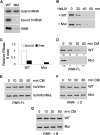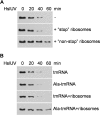Ribosomes regulate the stability and action of the exoribonuclease RNase R
- PMID: 24133211
- PMCID: PMC3843092
- DOI: 10.1074/jbc.M113.519553
Ribosomes regulate the stability and action of the exoribonuclease RNase R
Abstract
Ribonucleases play an important role in RNA metabolism. Yet, they are also potentially destructive enzymes whose activity must be controlled. Here we describe a novel regulatory mechanism affecting RNase R, a 3' to 5' exoribonuclease able to act on essentially all RNAs including those with extensive secondary structure. Most RNase R is sequestered on ribosomes in growing cells where it is stable and participates in trans-translation. In contrast, the free form of the enzyme, which is deleterious to cells, is extremely unstable, turning over with a half-life of 2 min. RNase R binding to ribosomes is dependent on transfer-messenger RNA (tmRNA)-SmpB, nonstop mRNA, and the modified form of ribosomal protein S12. Degradation of the free form of RNase R also requires tmRNA-SmpB, but this process is independent of ribosomes, indicating two distinct roles for tmRNA-SmpB. Inhibition of RNase R binding to ribosomes leads to slower growth and a massive increase in RNA degradation. These studies indicate a previously unknown role for ribosomes in cellular homeostasis.
Keywords: Escherichia coli; Protein Stability; RNA Metabolism; Ribonuclease; Ribosomes.
Figures







Similar articles
-
Distinct tmRNA sequence elements facilitate RNase R engagement on rescued ribosomes for selective nonstop mRNA decay.Nucleic Acids Res. 2014;42(17):11192-202. doi: 10.1093/nar/gku802. Epub 2014 Sep 8. Nucleic Acids Res. 2014. PMID: 25200086 Free PMC article.
-
Transfer-messenger RNA-SmpB protein regulates ribonuclease R turnover by promoting binding of HslUV and Lon proteases.J Biol Chem. 2012 Sep 28;287(40):33472-9. doi: 10.1074/jbc.M112.375287. Epub 2012 Aug 9. J Biol Chem. 2012. PMID: 22879590 Free PMC article.
-
A novel mechanism for ribonuclease regulation: transfer-messenger RNA (tmRNA) and its associated protein SmpB regulate the stability of RNase R.J Biol Chem. 2010 Sep 17;285(38):29054-8. doi: 10.1074/jbc.C110.168641. Epub 2010 Aug 5. J Biol Chem. 2010. PMID: 20688916 Free PMC article.
-
The role of RNase R in trans-translation and ribosomal quality control.Biochimie. 2015 Jul;114:113-8. doi: 10.1016/j.biochi.2014.12.012. Epub 2014 Dec 24. Biochimie. 2015. PMID: 25542646 Review.
-
A salvage pathway for protein structures: tmRNA and trans-translation.Annu Rev Microbiol. 2003;57:101-23. doi: 10.1146/annurev.micro.57.030502.090945. Epub 2003 May 1. Annu Rev Microbiol. 2003. PMID: 12730326 Review.
Cited by
-
Regulation of mRNA decay in E. coli.Crit Rev Biochem Mol Biol. 2022 Feb;57(1):48-72. doi: 10.1080/10409238.2021.1968784. Epub 2021 Sep 21. Crit Rev Biochem Mol Biol. 2022. PMID: 34547957 Free PMC article.
-
Identification of polyphosphate-binding proteins in Escherichia coli uncovers targets involved in translation control and ribosome biogenesis.mBio. 2025 Aug 13;16(8):e0050025. doi: 10.1128/mbio.00500-25. Epub 2025 Jul 7. mBio. 2025. PMID: 40621900 Free PMC article.
-
A view of pre-mRNA splicing from RNase R resistant RNAs.Int J Mol Sci. 2014 May 26;15(6):9331-42. doi: 10.3390/ijms15069331. Int J Mol Sci. 2014. PMID: 24865493 Free PMC article. Review.
-
The highly conserved bacterial RNase YbeY is essential in Vibrio cholerae, playing a critical role in virulence, stress regulation, and RNA processing.PLoS Pathog. 2014 Jun 5;10(6):e1004175. doi: 10.1371/journal.ppat.1004175. eCollection 2014 Jun. PLoS Pathog. 2014. PMID: 24901994 Free PMC article.
-
Bacterial ribonucleases and their roles in RNA metabolism.Crit Rev Biochem Mol Biol. 2019 Jun;54(3):242-300. doi: 10.1080/10409238.2019.1651816. Crit Rev Biochem Mol Biol. 2019. PMID: 31464530 Free PMC article. Review.
References
-
- Deutscher M. P. (2003) Degradation of stable RNA in bacteria. J. Biol. Chem. 278, 45041–45044 - PubMed
-
- Andrade J. M., Pobre V., Silva I. J., Domingues S., Arraiano C. M. (2009) The role of 3′-5′ exoribonucleases in RNA degradation. Prog. Mol. Biol. Transl. Sci. 85, 187–229 - PubMed
-
- Carpousis A. J., Luisi B. F., McDowall K. J. (2009) Endonucleolytic initiation of mRNA decay in Escherichia coli. Prog. Mol. Biol. Transl. Sci. 85, 91–135 - PubMed
-
- Deutscher M. P. (2009) Maturation and degradation of ribosomal RNA in bacteria. Prog. Mol. Biol. Transl. Sci. 85, 369–391 - PubMed
Publication types
MeSH terms
Substances
Grants and funding
LinkOut - more resources
Full Text Sources
Other Literature Sources
Molecular Biology Databases

